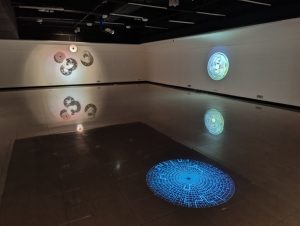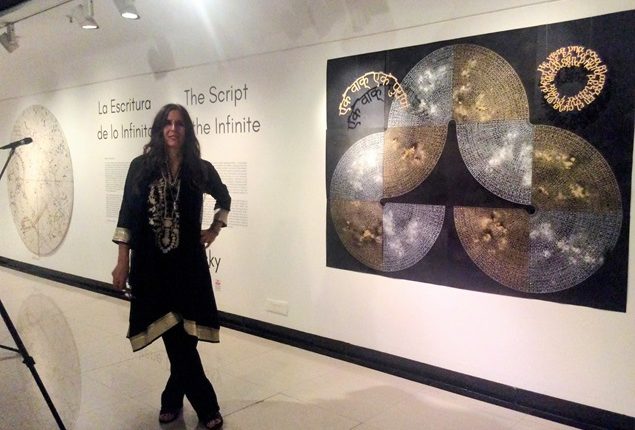Irene Dubrovsky is a Mexican-Argentinian visual artist whose work explores cosmic themes through vibrant and innovative art. Her installations blend visual elements with sound, using star maps to create musical scores. Currently in India for her exhibition, Dubrovsky shares with The Peeper Times her passion for cosmology-inspired art and the ways culture and history inspire her work.
1) What inspires your artwork, particularly your use of geometric patterns, astronomy and bright colours?
Every artist has a personal research focus; mine has centered on diagrams and maps, ancient codes and alphabets, and the creation of visual spaces that connect the inner processes of the human being with the cosmos.
2) Can you explain how you interpret the cosmos and its mysteries in your artwork?
Cosmological questions have always been present in my work, addressing the crossover between the art and the science, both traditionally and contemporarily.
3) How do you integrate visual and sound elements in your installations? What challenges do you face when combining these two mediums?
The star maps led me to imagine an installation of floating discs, which in turn are sound pieces. I have contemplated the night from observatories and deserts. Each star has a position on the map, a size, and a spectral type. All these elements allow me to develop a score using a sound code, where each celestial object corresponds to a specific note on the sound scale. In this way, my Star Discs are installations that allow you to hear the sound of the Cosmos from different locations.
The best advice for an artist is not to be afraid of being different or to try to follow the same path as others. Trust that an honestly pursued path will attract the right people to nurture it.
4) How do cultural elements influence your work, and why is it important for you to incorporate them?
There is a thread that connects the present with history. Contemporary art collects techniques and modes of production from the past. I work a lot with the cultural heritage of civilisations that have left us their memories carved in stone, in vestiges, ancient cities, pyramids and celestial temples.
5) How can your cosmology-inspired art be used as an educational tool in schools?
Awakening wonder and questioning in the face of the mystery of infinite space is one of the greatest contributions art can make, as well as broadening the mind’s perspective. We only know a fraction of the universe’s mysteries, and often, the intuition of art enables unexpected methodologies of knowledge.
6) What advice would you give to young aspiring artists who are still studying?
To trust that there is a path for everyone, not to try to follow the same approach or artistic strategy as their colleagues. There is an impulse that leads people to dedicate their lives to art, a question that sometimes accompanies the artist throughout his or her life. Art is always seeking the new, and in that sense, the best advice for an artist is not to be afraid of being different or to try to follow the same path as others. Trust that an honestly pursued path will attract the right people to nurture it.

7) What important skills or techniques should students develop?
Contemporary art is very open to incorporating historical techniques and making them dialogue with digital languages, video art, and more. In India, for example, textile art holds significant value for representing the memory of knowledge. Manuscripts, mandalas, and other ritual forms are also important.
8) How can educators support students in the search for art that intersects with scientific themes?
As an artist you must always look for dialogue with other disciplines, transcending closed borders. It is important to promote the idea of interdisciplinarity in young people – that art can be the result of crossing and dialogue. Art and science are two paradigms that can nurture and enrich each other.
9) Are you familiar with India’s historical contributions to astronomy, such as the Jantar Mantar observatories? How do these historical monuments inspire or influence your work?
Yes, I visited Jantar Mantar in Jaipur, where I found the largest observatory and sundial. An absolute marvel, a true prodigy that shows the knowledge of the cosmos and the relevance that this knowledge had and still has… I have been thinking of creating a series of three-dimensional works using these designs and engaging in dialogue with professionals from the Institute of Astrophysics of India.
As an artist you must always look for dialogue with other disciplines, transcending closed borders. It is important to promote the idea of interdisciplinarity in young people.
10) Do you see any parallels between your artistic interpretation of the cosmos and the way ancient civilisations, like those in India, approached astronomy?
There is a connection, of course, which is especially evident in including the human being in the equation — in the idea of the infinite as a dimension that unfolds within the human being as a contemplator and experiencer.
A collection of her recent works is on display at the Instituto Cervantes, New Delhi. The exhibition is open daily from 11 am to 7 pm and will run until September 30, 2024.
Do you feel strongly about something? Have a story to share? Write to us at info@thepeepertimes.com or connect with us on Facebook or X (Twitter)




Comments are closed, but trackbacks and pingbacks are open.